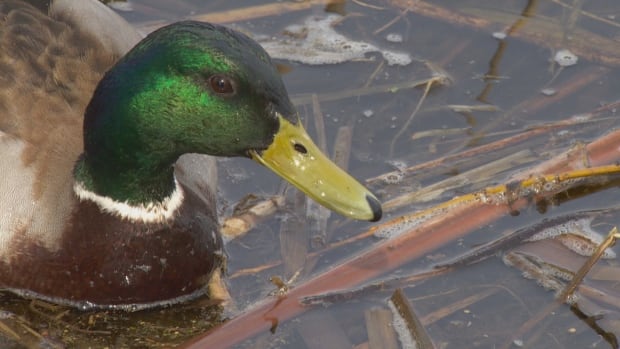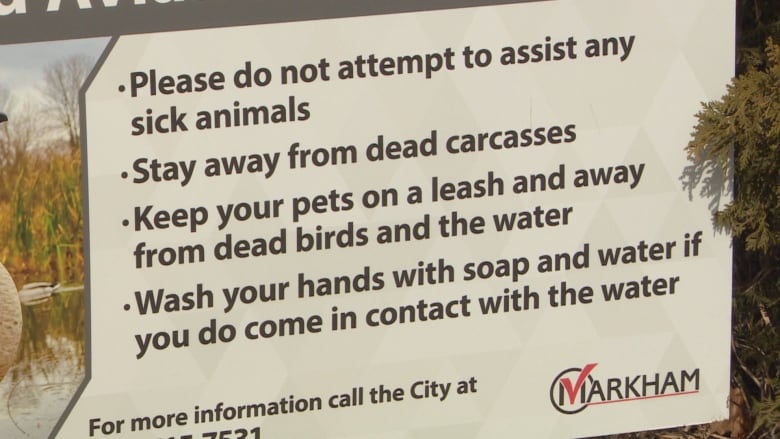
The worst of the bird flu epidemic on Canadian poultry farms seems to be over, but the highly contagious and deadly disease continues to spread among wild birds and farmers are worried spring and fall migrations will bring further outbreaks.
The highly pathogenic H5N1 strain of avian influenza was first detected in Canada in late 2021 and prompted the Canadian Food Inspection Agency to impose strict biosecurity measures to curb its spread.
Before egg farmer Juschka Clarke enters her chicken enclosure in Abbotsford, B.C., she takes special precautions.
“When we get to our barns, our footwear gets changed,” said Clarke. “We put on biosecure suits that make sure that we’re not bringing anything outside to inside our barns at all.”
She wants to protect her 4,000 laying hens from the worst outbreak of the avian flu in a decade.
Farmers across the country have lost seven million birds since late 2021.
The B.C. Egg Producers Association says about a million laying hens have been lost there to the contagious strain.
“When we walk into our barns we don’t know what we’re gonna see,” Clarke said. “They’re walking in and seeing catastrophes and disasters — it’s a high level of anxiety for sure.”
The good news is that stringent safety protocols may have had an impact and the worst is over for the poultry industry, at least for now.
Migration may bring outbreaks
Marc Bertrand, national operations veterinary specialist for the Canadian Food Inspection Agency, says the CFIA established primary control zones (PCZ) in the areas where the highly pathogenic avian influenza (HPAI) was detected. At the height of the outbreak, it declared 177 of these zones.
“Right now it seems that it’s finally receding. We are left with only two infected zones in Canada, both in Ontario,” he said.
The bad news, he says, is that if flocks of wild birds act as a reservoir for the virus, it will be back.
“There are two migration seasons every year, spring and fall. And those are the periods where we will see outbreaks.”

Brian Stevens is a wildlife pathologist with the Canadian Wildlife Health Cooperative in Guelph, Ont., said the problem has spread to Canada geese in the Greater Toronto Area. He has investigated several die-offs.
“We’ve tested a number of geese at this point and over the past two weeks … all of the geese that we have tested have come back positive for avian influenza virus,” he said.
Stevens says that more bird species appear susceptible to this strain of H5N1 than others — there more than 180 altogether — and there is evidence it has spread to some animals that eat infected bird carcasses, such as foxes and bears.
Virus spreading to mammals
“We’re definitely seeing a lot of different mammalian carnivores and likely these animals are scavenging on the wild birds as well,” he said.
“So that’s another thing that we’ve kind of come across with this one that we haven’t seen in past outbreaks is that the scavenger species are really getting hit hard by it.”
Eight skunks found dead last month in Richmond, B.C., and Vancouver tested positive for avian flu.
In Peru, authorities say more than 700 sea lions have died of avian flu since January.

Dr. Shayan Sharif, an avian immunologist with the Ontario Veterinary College in Guelph, Ont., said it’s disconcerting to hear the virus might be adapting to mammals.
“That is not a very good sign,” he said.
Sharif says the more chances this virus has to jump into mammals, the more chances it has to mutate, adapt and potentially spread between mammals.
‘We have to be ready’
“Our concern is that this virus at the moment, doesn’t have the capacity for spillover to the human population,” he said.
“Based on what we are seeing recently in mammals, there’s a possibility, even though it’s not very likely, but there is a possibility that it could also be lethal for humans.”
Sharif says it’s not too early to consider the possibility of a human avian flu pandemic and to have a plan.
“If we’ve learned just one lesson from COVID-19, it is the fact that viruses are quite unpredictable in terms of the mutations that they can accumulate. Highly unpredictable. So we have to be ready for that unpredictable future.”
In a statement to CBC News, Health Canada says although there are no domestically acquired human cases of H5N1 reported in Canada, and no sustained person-to-person transmission has been reported, it is taking precautions.
“The government of Canada maintains pandemic vaccine preparedness contracts in the event of a pandemic (including one caused by avian influenza), and currently has agreements with several manufacturers to secure priority access and reserve production capacity if needed to rapidly manufacture and deliver large numbers of vaccine doses to help protect people in Canada.“

